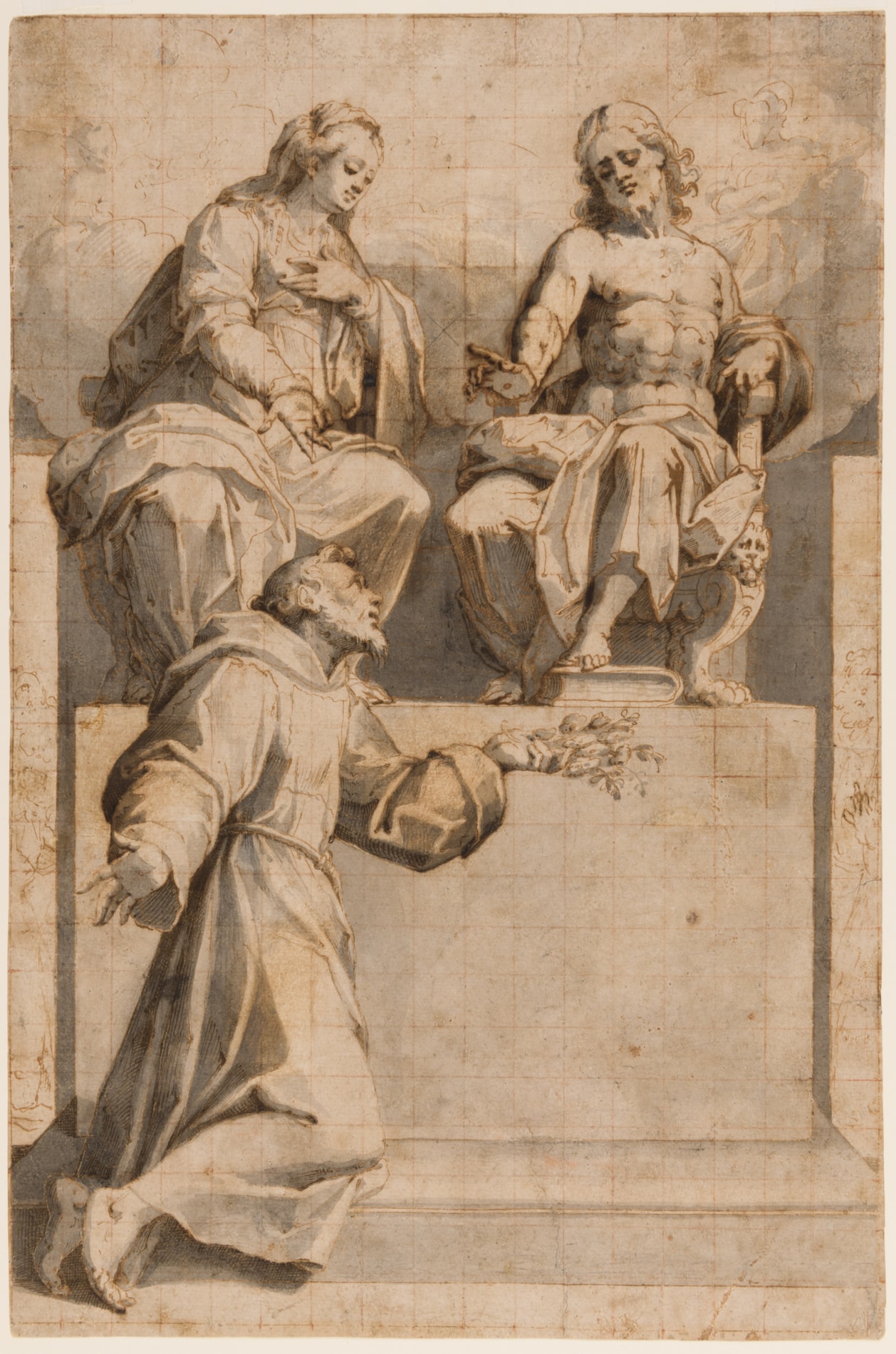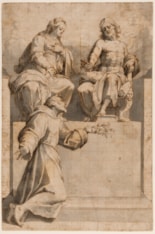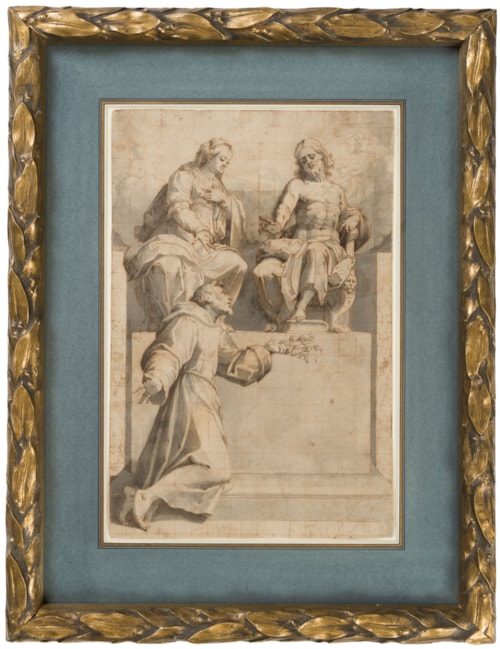Giovanni Battista Trotti MALOSSO
(Cremona 1556 - Parma 1619)
Christ Enthroned with the Virgin, Saint Francis Kneeling Below
Pen and brown ink and grey wash, squared for transfer in red chalk.
The figure of Saint Francis indented with the stylus and outlined in black chalk on the verso.
Inscribed LB (?) on the verso.
372 x 247 mm. (14 6/8 x 9 3/4 in.)
The figure of Saint Francis indented with the stylus and outlined in black chalk on the verso.
Inscribed LB (?) on the verso.
372 x 247 mm. (14 6/8 x 9 3/4 in.)
Malosso took great care over the preparatory drawings for his paintings. As Mario di Giampaolo has noted of the artist, ‘his extraordinary facility in experimenting with the most varied techniques of drawing contribute notably to the artistic statement of the master…the drawings connected with works completed at the end of the [16th] century display expert handling of the pen and wash.’ Related to two different paintings by Malosso, the present sheet is just such an example of a work from this fertile period.
This drawing may be a preparatory study, with differences, for Malosso’s altarpiece, signed and dated 1598, in the parish church at Manerbio, near Brescia. Malosso’s painting was later copied almost exactly by one of his pupils, Bartolomeo Bersani, in an altarpiece intended for the church of Sant’Angelo in Cremona and now in the chiesa parrochiale in the town of Solarolo Monasterolo. Bersani’s painting, which may have been made from the same cartoon as the Manerbio altarpiece, was correctly described in 1665 by one historian as a work designed by Malosso but painted by Bersani. Just over a hundred years later, however, some confusion seems to have arisen as to the true author of the Sant’Angelo altarpiece, with some authors believing it to be by the hand of the master himself and not his pupil, Bersani. Nevertheless, as Giovanni Battista Zaist noted of the altarpiece in his Notizie istoriche de’ pittori, scultori ed architetti cremonesi, published in 1774, ‘in this painting also one can clearly discern the character of Malosso, and some, who would like to appear all-knowing, not reading in it any name, have baptized it as his true work. But it is certainly not by that very noble author…A painting like this suffers from a great hardness, even though it has been taken from a very beautiful drawing, which I have seen, very soft and mellow, and which now rests in some secret nook…’
It has been suggested that Zaist was here referring to the present sheet by Malosso, although there remain a number of significant differences between the drawing and the two paintings mentioned above. The present drawing did, however, serve as a preparatory study for another painting by Malosso, signed and dated 1593, in the church of San Clemente in the town of Bertonico, near Lodi. In the Bertonico altarpiece, the figure of Saint John the Baptist joins Saint Francis on the lower tier of the composition.
This drawing may be a preparatory study, with differences, for Malosso’s altarpiece, signed and dated 1598, in the parish church at Manerbio, near Brescia. Malosso’s painting was later copied almost exactly by one of his pupils, Bartolomeo Bersani, in an altarpiece intended for the church of Sant’Angelo in Cremona and now in the chiesa parrochiale in the town of Solarolo Monasterolo. Bersani’s painting, which may have been made from the same cartoon as the Manerbio altarpiece, was correctly described in 1665 by one historian as a work designed by Malosso but painted by Bersani. Just over a hundred years later, however, some confusion seems to have arisen as to the true author of the Sant’Angelo altarpiece, with some authors believing it to be by the hand of the master himself and not his pupil, Bersani. Nevertheless, as Giovanni Battista Zaist noted of the altarpiece in his Notizie istoriche de’ pittori, scultori ed architetti cremonesi, published in 1774, ‘in this painting also one can clearly discern the character of Malosso, and some, who would like to appear all-knowing, not reading in it any name, have baptized it as his true work. But it is certainly not by that very noble author…A painting like this suffers from a great hardness, even though it has been taken from a very beautiful drawing, which I have seen, very soft and mellow, and which now rests in some secret nook…’
It has been suggested that Zaist was here referring to the present sheet by Malosso, although there remain a number of significant differences between the drawing and the two paintings mentioned above. The present drawing did, however, serve as a preparatory study for another painting by Malosso, signed and dated 1593, in the church of San Clemente in the town of Bertonico, near Lodi. In the Bertonico altarpiece, the figure of Saint John the Baptist joins Saint Francis on the lower tier of the composition.
Active as both a painter and an architect, Giovanni Battista Trotti, known as Il Malosso, was the foremost pupil of Bernardino Campi, whose studio he later inherited. Although his early works are indebted to the manner of Campi and such Cremonese contemporaries as Bernardino Gatti, he was also particularly influenced by the work of Correggio. From 1585 onwards he was especially active, painting numerous altarpieces for churches in Cremona, notably San Pietro al Po and Sant’Abbondio. The end of the 16th century and the beginning of the Seicento found Malosso working extensively throughout Lombardy - in Lodi, Pavia, Piacenza, Salò and Milan – as well elsewhere in Northern Italy, notably Genoa and Venice. In 1604 he settled in Parma, where he was employed at the court of the Duke Ranuccio Farnese. His work as a court artist in Parma included commissions for frescoes and portrait paintings, the decoration of various rooms in the Palazzo del Giardino, and temporary decorations for court festivals. He also supervised architectural projects, made designs for engravings and, for the Duke’s son Ottavio Farnese, was a painting teacher. Malosso’s work in Parma also included paintings for the Capuchin church at Fonteviva. Although firmly established as a court painter in Parma, Malosso continued to supervise a busy workshop in Cremona, where he provided several designs for altarpieces and frescoes. Among his most important pupils was Ermenegildo Lodi, who was active in Cremona between 1598 and 1616.
Malosso was admired as a draughtsman in his lifetime, and his drawings were sought after by collectors and connoisseurs long after his death. As the later 17th century Florentine biographer Filippo Baldinucci noted of the artist, ‘one sees a great many drawings by his hand done in pen and touches of wash with great clarity and facility’, while in the 18th century Giovanni Battista Zaist, in his biographical account of Cremonese artists, commented of Malosso that ‘the drawings of this renowned master, being works of consummate taste, have come to be held in the highest esteem; one therefore finds the greatest number of these in good collections not only in Cremona, Milan, and other nearby cities, but in the still more famous ones in Tuscany.’ Among the prominent 17th century collectors of Malosso’s drawings was Cardinal Leopoldo de’ Medici, much of whose collection is now in the Uffizi in Florence.
Provenance
Rossella Gilli, Milan, in 1986
Private collection, Cremona
Anonymous sale, London, Sotheby’s Olympia, 13 December 2001, lot 60
Jean-Luc Baroni Ltd., London, in 2002
Private collection, New York.
Private collection, Cremona
Anonymous sale, London, Sotheby’s Olympia, 13 December 2001, lot 60
Jean-Luc Baroni Ltd., London, in 2002
Private collection, New York.
Literature
Possibly Giovanni Battista Zaist, Notizie istoriche de’ pittori, scultori ed architetti cremonesi, Cremona, 1774, Vol.II, p.38; Marco Tanzi, Qualche aggiunta al Malosso e alla sua cerchia, Prospettiva, January 1985, pp.83-84, fig.6; Gianluca Bocchi and Ulisse Bocchi, Alcune novità e precisazione sul Malosso e sulla sua cerchia, Parma per l’arte, 2017, p.180, fig.7.
Exhibition
Milan, Galleria Rossella Gilli, Disegni Lombardi dal XV al XVIII secolo, 1986, no.32.








